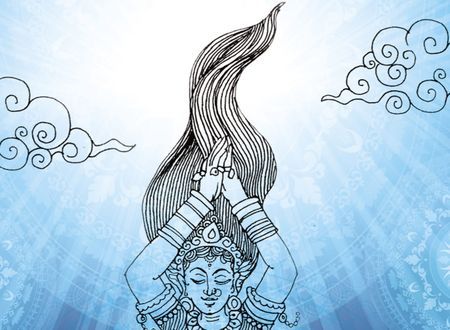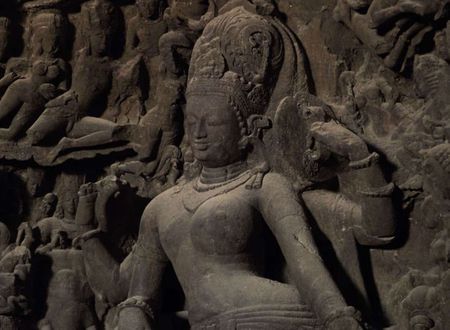Immense gratitude to Sri Devi Om for starting ‘The Virtual Writing Satsang’ Series and Roopa for inspiring me through her research. Both of you made me sit down and reflect and research on what actually Satsang means to us and why we even need to know or think about it. What is it that we are losing by remaining ignorant about Satsang and what will we gain by learning more about Satsang?
SATSANG (Hinduism)
The word SATSANG is derived from two words, ‘Sat’ meaning the absolute existence, it is the essential nature of ‘Brahman’ while ‘Sanga’ means ‘company’ or ‘union’. To be established in Brahman is the literal meaning of the word Satsang. Thus, Satsang refers to ‘being in the company of Brahman’. Brahman is the only one who is permanent; the one who is omnipresent, omniscience, and omnipotent. Here Brahman and Isvara both are considered one and the same. Thus the literal meaning of Satsang is to be always in the company of the Lord. The Brahman is not going to do anything. He is simply there, available. If we are open, he will flow within us. This flowing is called Satsang. With a Brahman we need not learn anything else. If we can learn Satsang, that’s enough – if we can just be near him without asking, without thinking, without arguing: just present there, available, so the being of the Brahman can flow in us. And being can flow. It is already flowing. Whenever a person achieves integrity, his being becomes a radiation.
The other possible interpretation is when we feel such devotion for God that He has to come to us in a form according to our desire. The means to this realisation is also called Satsang. The company of the wise leads to the realisation of Brahman and, therefore, is also termed Satsang. In this sense, Satsang means the company of those who have realised truth, as well as those who are aspirants after truth.
Satsang gives one spiritual illumination and is one of the fundamental means for attaining God-realization.
It is only when ignorance or Avidya is destroyed by wisdom and enlightenment; the highest form of Satsang is achieved. Again, one can only reach this state through his/ her unflinching devotion towards the Lord. The way the Lord appeared Himself in front of the Gopis for their selfless love and emotions towards Him; the same way our bhakti (devotion) should also be such that it pleases the Lord and He remains in union (Satsang) with us.
SANGAT (Sikhism)
Sangat (Punjabi: ਸੰਗਤ) is a Sikh term with its origin in the Sanskrit word Sangh, generally refers to companions or the collective body of Sikhs who are the members of a congregation. Sangat may also mean fellowship, the gathering of spiritual companions in an assembly with associates of like minded souls, essentially the company one keeps. It is the community of people who meet and worship in the gurdwara in the presence of the Guru Granth Sahib, which is the Sikh holy book. The Sangat sings hymns together (Kirtan), meditate on God’s name (Nam Japna) and listen to musicians (Ragis).
Sangat is sometimes analogous to Sat-Sangat (Fellowship of the seekers of truth) and Sadh-Sangat (Congregation of a Sadh or Sant). The word Sangat has been in use since the time of Guru Nanak (1469-1539). In his days and those of his nine successors, Sangat referred to the Sikh brotherhood established in or belonging to a particular locality. In Sikhism there is a strong push for one to be a part of the Sangat as well as to avoid Ku-Sangat (Undesirable Sangat).
In Sikhism, the moral traits of Sangat are very important and are mentioned in both scripture of Guru Granth Sahib and the code of conduct.The Sikh Gurus formulated a social code which prohibits association with the undesirable society of daughter killers, drunkards, gamblers, thieves, thugs, tobacco smokers. Willful engagement in immoral activities, or breach of conduct may subject the perpetrator to boycott, or excommunication and shunning. The Gurus wrote scripture extolling the virtues of pious sangat:
- “Sant janaa mil sangatee gurmukh teerath hoe”
Meeting with Saintly society one faces toward the enlightener as though making pilgrimage to a sacred shrine.” 1st Guru Nanak Dev SGGS||597 - “Jis no aapae rangae su rapsee satsangat milaae”
Only those whom the Lord imbues are so imbued, they join the True Congregation. - “Poorae gur tae satsangat oopjai sehjae sach subhaa-e”
From the perfect Enlightener, the guild of saintly companions emanates, and one easily embraces Love of the True One’s glory.” - “Bin sangatee sabh aisae reheh jaisae pas ddhor”
Without the association of righteous society, all remain like beastly animals. - “Jinh keetae tisai na jaananhee bin naavai sabh chor”
They know not the One who created them; without the Name, they are all thieves.” 3rd Guru Amar Das SGGS||427
SANGHA (Jainism)
Sangha in Jainism simply refers to the “community” of those practicing dharma to achieve spiritual liberation at the end of life. Sangha (Community of the pious) is a term used to refer to the fourfold community of Muni (male ascetics), Aryika / Sadhvi (female ascetics), Sravaka (laymen), and Sravika (laywomen).
According to Champat Rai Jain, an influential 20th century Jain writer (Risabha Deva – The founder of Jainism, published in 1929) described the Sangha as “those who practise the dharma”, “the community of the saints”, “the community of the pious” and as “the community of the faithful”. In the same book he also mentions that the Sangha will be maintained till the very end of the present strife-ridden spoke of time (pancham kaal). With the end of the sangha, the dharma (religion) will also end.
SANGHA (Buddhism)
The word sangha means to “bring together” into a group and is the general word for “community” in Pali. It can refer to a flock of crows or a herd of deer, but in Buddhist literature it is primarily used to refer to the Buddhist community.
Most often Sangha refers to the formal community of monks and nuns, and as such it is often capitalized in English usage. This is especially the case when it is listed as part of the “triple gem”: the Buddha, Dhamma, and Sangha (the Awakened One, his Teaching, and his Community). Traditionally one joins the Sangha by a formal act of renouncing all possessions and worldly relationships, and then “goes forth” into the homeless life of a monk or nun.
The early Buddhist community was actually composed of four parts, with the addition of a community of lay followers (literally, those who hear the teachings) divided into male and female adherents. The Buddha is often depicted as teaching the “fourfold assembly,” surrounded by monks, nuns, and male and female lay followers. One would formally join the lay community by chanting Buddham Saranam Gacchami, Dhammam Saranam Gacchami, Sangham Saranam Gacchami (I go for refuge to the Buddha, Dhamma, and Sangha) three times.
More recently the word Sangha has been extended even wider in the West to include almost anyone with an interest in Buddhist thought and practice. Local temples and retreat centers refer to their participants as Sangha members, and people look to join meditation communities or affinity groups that self-identify as Sanghas.
Finally, the word can be extended to encompass all sentient beings—and even all inhabitants of a unified ecosystem—as members of a single Sangha. This inspiring vision brings with it a heightened sense of connection, a greater appreciation of mutual interdependence, and a shared responsibility for all beings to respect and care for one another.
The most intriguing insight has been observed on the sangha is Buddhadasa Bikkhu’s observation that “voidness is the sangha” From ‘Heartwood of the Bodhi Tree’: “The true Buddha, Dharma and Sangha abide in the void mind.”
In this light, it has nothing to do with hanging out with people.
P.S. This post is not at all my original work. The sources are multiple albeit from internet. On this journey of writing this post, I stumbled upon books and scriptures written which were not there in my awareness at all.
**************
I offer this very first article of my life at the Holy feet of my beloved Om Swami.
Jai Sri Hari









Comments & Discussion
12 COMMENTS
Please login to read members' comments and participate in the discussion.